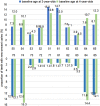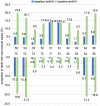Factors Affecting Future Caries Occurrence Among Preschoolers in Northern Guangdong: A Longitudinal Study
- PMID: 34079377
- PMCID: PMC8164668
- DOI: 10.2147/CLEP.S312132
Factors Affecting Future Caries Occurrence Among Preschoolers in Northern Guangdong: A Longitudinal Study
Abstract
Purpose: This study aimed to investigate the new development of caries among preschoolers in northern Guangdong and to assess caries-related factors to distinguish groups with different caries risk levels.
Methods: Baseline data were recorded for participants from September to November 2019, and participants were reexamined from September to November 2020. A longitudinal observation of 11,973 preschoolers was conducted. The simplified debris index (DI-S) and decayed-missing-filled tooth (dmft) index values were obtained for each participant.
Results: Factors associated with whether caries would occur in the future and one-year increase in dmft (Δdmft) included baseline dmft, baseline DI-S, and baseline age. The risk ratio (RR) of caries occurrence and the number of teeth with new-onset caries were 4.482 (95% confidence interval, 4.056-4.957) and 2.945 (2.742-3.165) in the participants with baseline dmft ≥3, which were higher than those with baseline dmft =1 or 2. In the baseline caries-free group, whether caries would occur in the future was related to the baseline DI-S (95% confidence interval, 0.022-0.062). The caries incidence of maxillary central incisors (27.9%) was the highest among teeth of preschoolers without caries at baseline, whereas the caries incidence of mandibular first deciduous molars (42.7%) was the highest among teeth of preschoolers with caries at baseline.
Conclusion: Baseline dmft is a good predictor of future caries. Children with baseline caries-free status, baseline dmft >0, and baseline dmft ≥3 should be treated with preventive interventions of different intensities and frequencies. The occurrence of future caries in baseline caries-free participants is related to oral hygiene status. Measures to prevent caries on smooth surfaces, such as topical fluoridation, should be applied to all preschoolers. Preschoolers with caries at baseline may be given priority for pit and fissure sealing.
Keywords: caries risk; oral epidemiology; preschool children; previous caries experience; simplified debris index.
© 2021 Yan et al.
Conflict of interest statement
The authors declare no conflicts of interest in this work.
Figures






Similar articles
-
Exploring the cost-effectiveness of child dental caries prevention programmes. Are we comparing apples and oranges?Evid Based Dent. 2020 Mar;21(1):5-7. doi: 10.1038/s41432-020-0085-7. Evid Based Dent. 2020. PMID: 32221482
-
A cross sectional study to evaluate the oral health status of children with intellectual disabilities in the National Capital Region of India (Delhi-NCR).J Intellect Disabil Res. 2019 Jan;63(1):31-39. doi: 10.1111/jir.12553. Epub 2018 Oct 18. J Intellect Disabil Res. 2019. PMID: 30338591
-
Fissure sealant retention and caries development after resealing on first permanent molars of children with low, moderate and high caries risk.Eur Arch Paediatr Dent. 2009 Dec;10(4):211-7. doi: 10.1007/BF03262684. Eur Arch Paediatr Dent. 2009. PMID: 19995504
-
The status and associated factors of early childhood caries among 3- to 5-year-old children in Guangdong, Southern China: a provincial cross-sectional survey.BMC Oral Health. 2020 Sep 25;20(1):265. doi: 10.1186/s12903-020-01253-w. BMC Oral Health. 2020. PMID: 32977784 Free PMC article.
-
Caries prevalence in primary teeth as a predictor of early fissure caries in permanent first molars.Community Dent Oral Epidemiol. 1992 Feb;20(1):30-4. doi: 10.1111/j.1600-0528.1992.tb00669.x. Community Dent Oral Epidemiol. 1992. PMID: 1547609
Cited by
-
Multilevel Interventions and Dental Attendance in Pediatric Primary Care: A Cluster Randomized Clinical Trial.JAMA Netw Open. 2024 Jul 1;7(7):e2418217. doi: 10.1001/jamanetworkopen.2024.18217. JAMA Netw Open. 2024. PMID: 38980678 Free PMC article. Clinical Trial.
-
The prevalence of dental caries and its associated factors among preschool children in Huizhou, China: a cross-sectional study.Front Oral Health. 2024 Aug 30;5:1461959. doi: 10.3389/froh.2024.1461959. eCollection 2024. Front Oral Health. 2024. PMID: 39280639 Free PMC article.
-
Effectiveness of online caries management platform in children's caries prevention: A randomized controlled trial.Front Public Health. 2023 Feb 9;11:1102503. doi: 10.3389/fpubh.2023.1102503. eCollection 2023. Front Public Health. 2023. PMID: 36844857 Free PMC article. Clinical Trial.
-
Understanding and reducing delayed dental care for early childhood caries: a structural equation model approach.BMC Public Health. 2025 Feb 7;25(1):523. doi: 10.1186/s12889-025-21701-y. BMC Public Health. 2025. PMID: 39920606 Free PMC article.
References
-
- American Academy of Pediatric Dentistry. Caries-risk assessment and management for infants, children, and adolescents. Pediatr Dent. 2018;40(6):205–212. - PubMed
LinkOut - more resources
Full Text Sources

